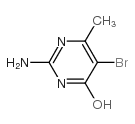4(3H)-Pyrimidinone,2-amino-5-bromo-6-methyl-

4(3H)-Pyrimidinone,2-amino-5-bromo-6-methyl- structure
|
Common Name | 4(3H)-Pyrimidinone,2-amino-5-bromo-6-methyl- | ||
|---|---|---|---|---|
| CAS Number | 6307-35-3 | Molecular Weight | 204.02500 | |
| Density | 2.04 g/cm3 | Boiling Point | 280.9ºC at 760 mmHg | |
| Molecular Formula | C5H6BrN3O | Melting Point | 244-246 °C(lit.) | |
| MSDS | Chinese USA | Flash Point | 123.7ºC | |
| Symbol |

GHS07 |
Signal Word | Warning | |
|
Comparation interferon- inducing and antiviral properties of 2-amino-5-bromo-6-methyl-4-pyrimidinol (U-25,166), tilorone hydrochloride, and polyinosinic-polycytidylic acid.
Antimicrob. Agents Chemother. 11(6) , 984-92, (1977) 2-Amino-5-bromo-6-methyl-4-pyrimidinol (U-25,166), polyinosinic acid-polycytidylic acid [poly(I:C)], and tilorone HCl induced high levels of serum interferon in mice. Each consequently protected mice against infection with several viruses. After daily injecti... |
|
|
Enhancement of resistance to Listeria monocytogenes infection in mice by pyrimidine analogs.
Clin. Invest. Med. 7(4) , 343-8, (1984) The modulation of murine host resistance to infection with Listeria monocytogenes by the substituted pyrimidine anti-viral compounds, 2-amino-5-bromo-6-methyl-4-pyrimidinol (ABMP), 2-amino-5-bromo-6-phenyl-4-pyrimidinol (ABPP) and 2-amino-5-iodo-6-phenyl-4-py... |
|
|
Antineoplastic properties of pyrimidinone interferon inducers.
Adv. Enzyme Regul. 19 , 335-48, (1980)
|
|
|
Interferon induction by 5-halo-6-phenyl pyrimidinones.
J. Interferon Res. 1(1) , 1-14, (1980) The interferon inducing characteristics of a new series of 6-phenyl pyrimidinol compounds are described and compared against a previously identified pyrimidine, 2-amino-5-bromo-6-methyl-4-pyrimidinol (ABMP). Interestingly, a split in ability to induce interfe... |
|
|
Varying role of alpha/beta interferon in the antiviral efficacy of synthetic immunomodulators against Semliki Forest virus infection.
Antiviral Res. 15(3) , 241-54, (1991) The question of whether interferon alpha/beta is the common mechanism of antiviral action of synthetic immunomodulators was investigated in B6C3F1 mice infected with Semliki Forest virus. Mice were treated with various concentrations of normal sheep serum or ... |
|
|
Antiviral and interferon-inducing properties of interferon inducers administered with prostaglandins.
Antimicrob. Agents Chemother. 17(3) , 455-60, (1980) Prostaglandins enhanced the interferon response and therapeutic activity of interferon inducers in Friend leukemia virus-infected mice. A similar enhancement in interfron responsiveness but not antiviral activity was observed in mice infected with rapidly acu... |
|
|
Membrane fluidity and cholesterol in thymus and spleen cells from mice treated with immunomodulatory drugs.
Immunopharmacology 5(1) , 49-64, (1982) We have used spin labeling, fluorescence polarization, and chemical analysis to characterize membrane properties of thymocytes from mice treated with immunomodulatory drugs. The number of thymocytes was reduced 90-95% by treatment of 6-9 week old mice with hy... |